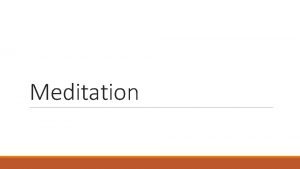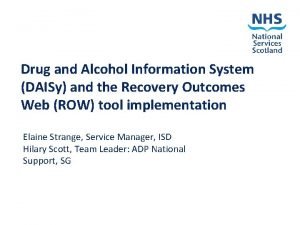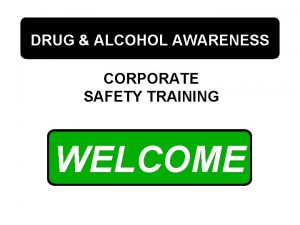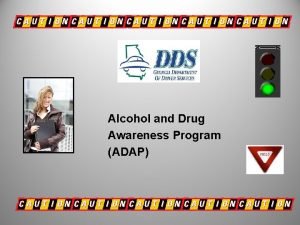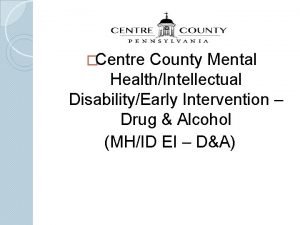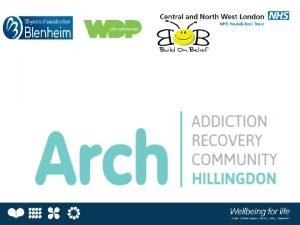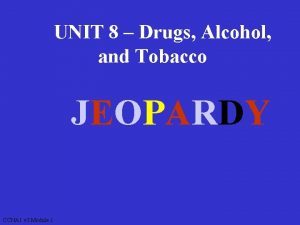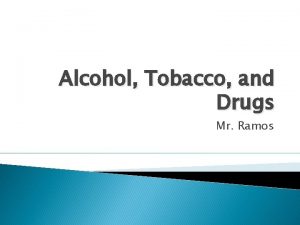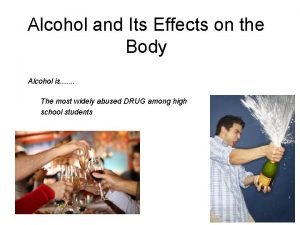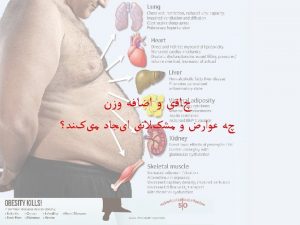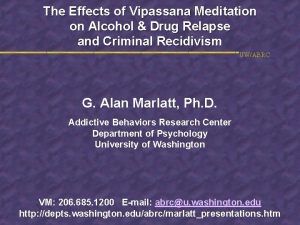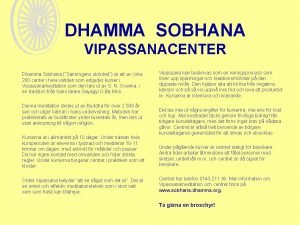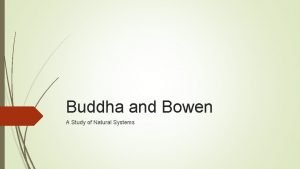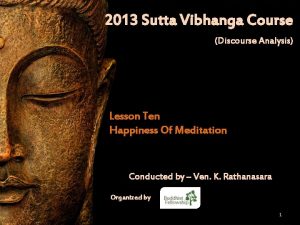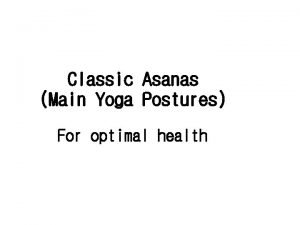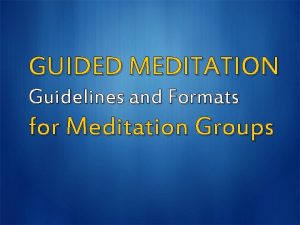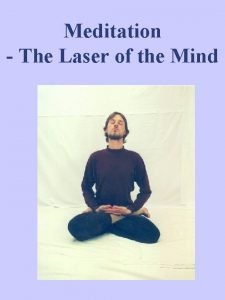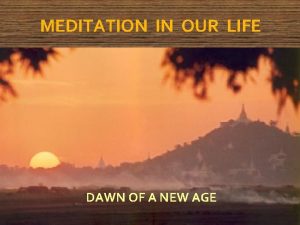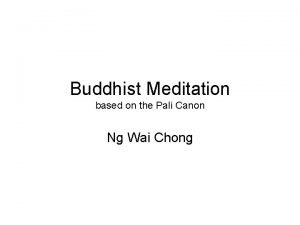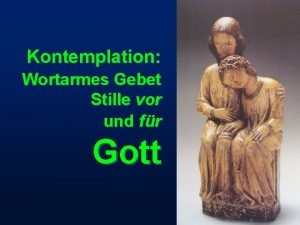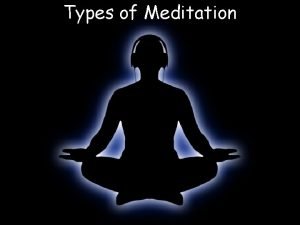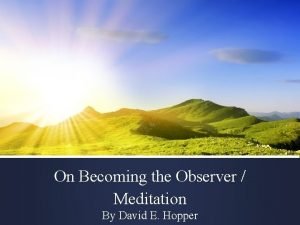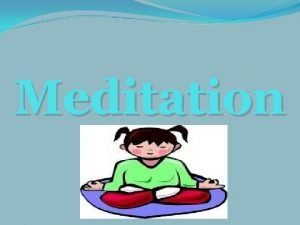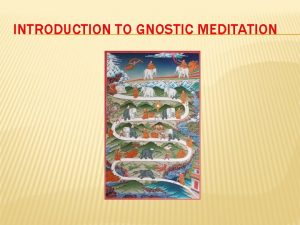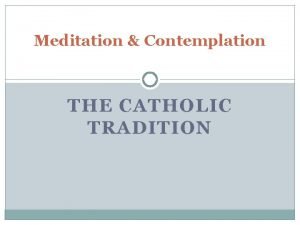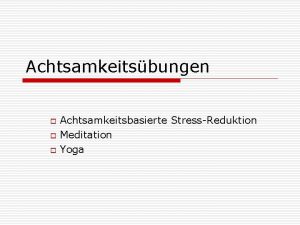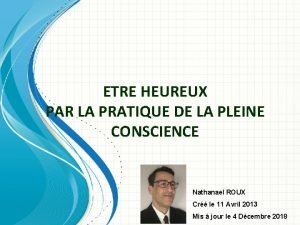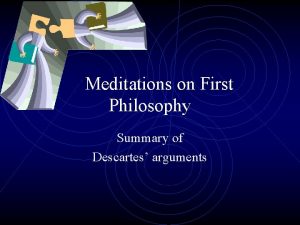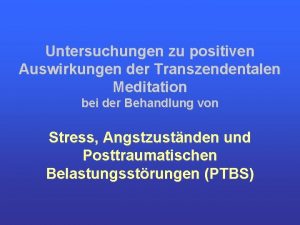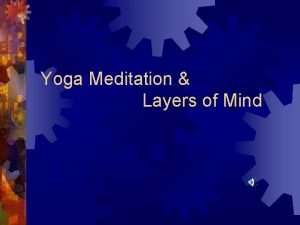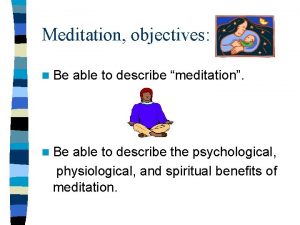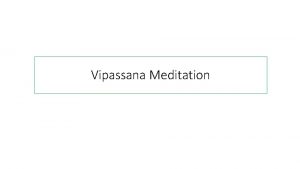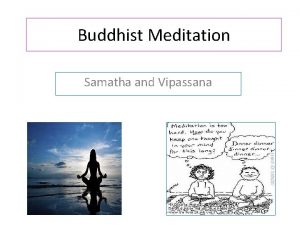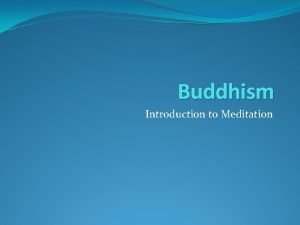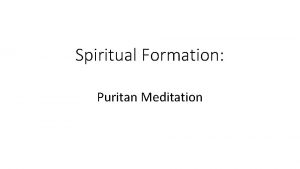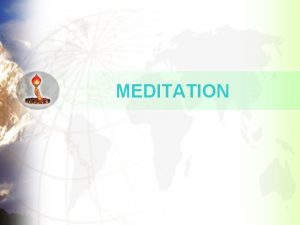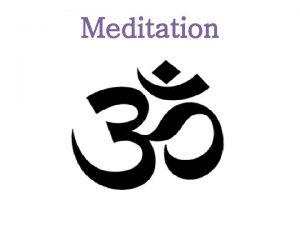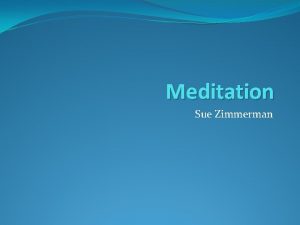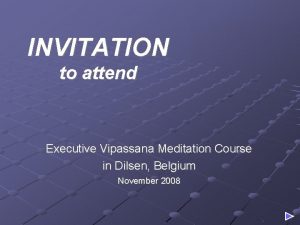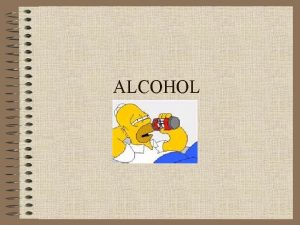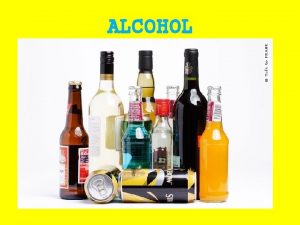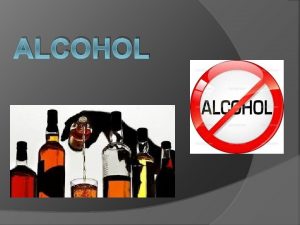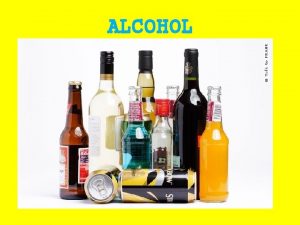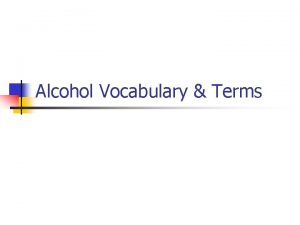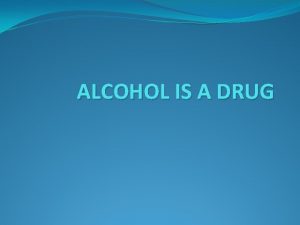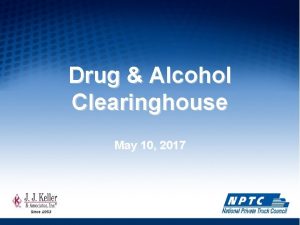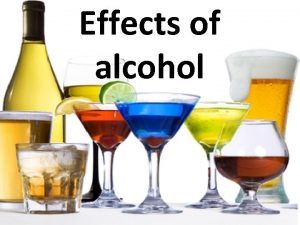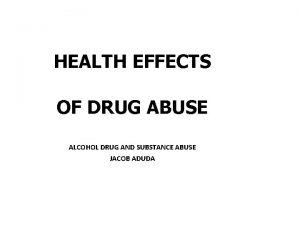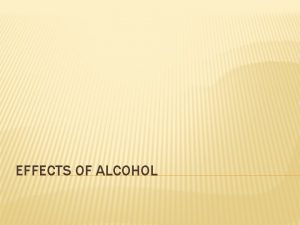The Effects of Vipassana Meditation on Alcohol Drug











































- Slides: 43

The Effects of Vipassana Meditation on Alcohol & Drug Relapse and Criminal Recidivism UW/ABRC G. Alan Marlatt, Ph. D. Addictive Behaviors Research Center Department of Psychology University of Washington VM: 206. 685. 1200 E-mail: abrc@u. washington. edu http: //depts. washington. edu/abrc/marlatt_presentations. htm




Project Choices Team UW/ABRC PRINCIPAL INVESTIGATOR G. Alan Marlatt, Ph. D CO-PRINICIPAL INVESTIGATORS Mary Larimer, Ph. D Arthur Blume, Ph. D Tracy Simpson, Ph. D RESEARCH COORDINATORS George A. Parks, Ph. D Jessica M. Cronce RESEARCH STUDY ASSISTANTS James K. Buder Tiara Dillworth GRADUATE RESEARCH ASSISTANTS Laura Mac. Pherson Katie Witkiewitz Sarah Bowen

Introduction UW/ABRC From 1970 to 1997, the number of substance-involved offenders has increased from 21, 266 prisoners in the Federal Bureau of Prisons with 16% being drug offenders to 98, 483 incarcerated individuals of which over 60% are drug offenders.

Introduction UW/ABRC There is evidence that other spiritual interventions besides AA, particularly meditation-based interventions, are associated with reduced alcohol and substance use.

Introduction UW/ABRC Two types of spiritually-based meditation techniques, Transcendental Meditation (TM), and to a lesser extent Vipassana meditation, have been evaluated as treatments for substance abuse, with encouraging results (Alexander et al. , 1994; Marlatt & Kristeller, 1998).

Introduction UW/ABRC Marlatt et al. (1984) found that the meditation (CSM), progressive relaxation, and bibliotherapy all lead to significant reductions in alcohol consumption during the training period compared to the no-treatment control subjects.

Introduction UW/ABRC Vipassana meditation, the intervention addressed in this study, is rooted in traditional Buddhist teachings and has been made available to practitioners around the world by the revered Buddhist teacher, S. N. Goenka (Hart, 1987).

Introduction UW/ABRC Preliminary results from research with inmate populations in India indicate that Vipassana meditation helps in reducing recidivism, reducing psychopathological symptoms, and increasing more positive behaviors such as cooperation with prison authorities (Chandiramani et al. , 1995; Kumar, 1995; and Vora, 1995).

Introduction UW/ABRC § Vipassana has also been implemented in correctional facilities within the United States. § The first Vipassana course in a North American correctional facility was conducted at the North Rehabilitation Facility (NRF) in Seattle, Washington in 1997.

Introduction UW/ABRC § Prior to closing in the fall of 2002, NRF was a minimum-security jail facility with an adult male and female inmate population of approximately 300. § Between January 2001 and November 2002, nine ten-day courses were held at NRF and included in the study.

Research Aims UW/ABRC § Document the effectiveness of a specific spiritual practice, Vipassana Meditation, for reducing alcohol and drug relapse, alcohol-related negative consequences, and criminal recidivism in a correctional population. § Evaluate several domains of spirituality as mediators and moderators of the effectiveness of Vipassana meditation on alcohol and drug relapse, criminal recidivism, mental health, and spiritual outcomes in this population. § Evaluate participant characteristics as predictors of willingness to participate in Vipassana meditation.

Participants UW/ABRC § n=305, 244 men and 61 women recruited from NRF § 61% Caucasian, 11% Native American, 7% Latino/Latina, 13% African-American, 2% Asian, 6% other § Average 37. 8 years old § 56% employed at least part-time prior to incarceration § 79% GED or high school diploma § 58% Christian, 17% no formal religion, 25% other § 26% attended religious services more than 1 x month, 34% less than 1 x month, 40% never

Most common charges/convictions (in order of frequency): UW/ABRC 1. Driving Under the Influence of Intoxicants 2. Theft 3. Violation of the Uniform Controlled Substance Act (VUCSA) 4. Driving with License Suspended (typically suspended due to previous DUI) 5. Assault/Domestic Violence 6. Possession of Stolen Property 7. Harassment 8. Prostitution 9. Criminal Trespass 10. Hit and Run

Procedure UW/ABRC § Participants self-selected to participate in the 10 -day Vipassana meditation course § Inmates could participate in the Vipassana course and not participate in the research study § Participants in both the Vipassana and control conditions completed baseline measures approximately 1 week prior to the first day of the Vipassana course § All participants completed a post-course assessment approximately 2 -3 days after the last day of the Vipassana course while still incarcerated

Procedure UW/ABRC § Participants who completed both baseline and postcourse were eligible for longitudinal follow-up (59 Vipassana; 107 control) § Follow-up assessments are administered onsite at the University of Washington 3 - and 6 -months post-release § Thus far, 49 Vipassana participants & 65 participants in the control group have completed the 3 -month follow-up questionnaire, and 6 -month follow-up is underway § Case-matching of Vipassana and control participants will occur after data collection is complete, prior to final data analysis

Pre-Course (Baseline) Assessment Participant Characteristics UW/ABRC § § § § Age Ethnicity Education Work status Religious background and practices Criminal history PTSD

Pre-Course (Baseline) Assessment Spiritual and Religious Domains UW/ABRC § LOT-Optimism § RBBQ-Religious Beliefs and Behaviors Questionnaire § RCAS-Religious Coping Scale § Meaning Scale § DES-Daily Spiritual Experiences Scale

Pre-Course (Baseline) Assessment Alcohol Use (90 days pre-NRF) UW/ABRC § § § § DDQ-R Daily Drinking Questionnaire Alcohol Q/F Index AUDIT-Screening ADS - Dependency DRIE – Locus of Control ICS – Impaired Control SIP-2 R - Consequences

Pre-Course (Baseline) Assessment Drug Use (90 days pre-NRF) UW/ABRC § DDTQ – Daily Drug-taking Questionnaire § ASI – Quantity/frequency of AOD § DAST – Drug Dependency

Pre-Course (Baseline) Assessment Thinking, Motivation, Distress UW/ABRC § Marlowe-Crown – Social Desirability § SRQ – Self-Regulation Questionnaire § WBSI – White Bear Suppression Inventory § RCQ – Readiness to Change Questionnaire § BSI – Psychopathology Screening

Pre-Course (Baseline) Assessment Recidivism and AOD Relapse UW/ABRC § TLFB (90) – Timeline Followback § Criminal History/ Recidivism

Post-Course and Follow-up Assessments UW/ABRC Post-Course Assessment: § All measures except participant characteristics and alcohol/drug items 3 - & 6 -month Follow Up Assessments: § All measures except participant characteristics § Addition of TLFB for AOD Relapse and Recidivism


Preliminary Analyses UW/ABRC § These analyses only include a subset of the sample that has completed both baseline and 3 -month followup. Additional research participants will be assessed at 3 - and 6 -months before final results are available. § The comparisons reported represent group mean differences from Time 1 (90 days prior to incarceration, retrospective) to Time 2 (3 -months post-release) and were calculated before case matching could take place. Final results will include only Vipassana course completers and their case-matched controls.

Preliminary Analyses UW/ABRC § Preliminary analyses of variance were conducted to explore the repeated measures effect of the meditation intervention on a variety of the psychosocial and alcohol/drug use dependent variables. § Recognizing that running multiple significance tests may inflate Type I error rates, future reports of the complete data set will use a Bonferroni corrected alpha level. § However, given the small sample size and exploratory nature of these analyses, results that were significant at p =. 05 are reported.

Changes from Pre-Course to 3 -month Follow-up: Main Effects for Time UW/ABRC Measure/Domain F p Religious Coping Activities 5. 55 . 02 Meaning Scale 5. 15 . 03 Peak weekly alcohol use 30. 95 . 0005 Peak weekly heroin use 8. 89 . 004

Changes from Pre-Course to 3 -month Follow-up: Group x Time Interaction Effects UW/ABRC Measure/Domain Locus of control (DRIE) Impaired Control Scale Thought suppression (WBSI) Optimism (LOT) Depression (BSI) Hostility (BSI) Alcohol consequences (SIP total) Drug addiction (DAST) Peak weekly tobacco use Peak weekly powder cocaine use Peak weekly crack cocaine use Peak weekly marijuana use F 4. 44 8. 17 4. 57 13. 53 4. 54 4. 24 3. 95 6. 28 5. 46 9. 80 4. 82 4. 21 p. 04. 006. 04. 001. 04. 05. 02. 003. 04

Changes from Pre-Course to 3 -month Follow-up: Alcohol Related Negative Consequences UW/ABRC SIP Total Score

Changes from Pre-Course to 3 -month Follow-up: Locus of Control UW/ABRC DRIE Total Score

Changes from Pre-Course to 3 -month Follow-up: Drug Abuse/Dependence UW/ABRC DAST Total Score

Changes from Pre-Course to 3 -month Follow-up: Psychopathology (Depression) UW/ABRC BSI Depression Scale Score


Discussion UW/ABRC To be mindful is to be aware of the full range of experiences that exist, to bring one’s complete attention to the present experience on a moment-tomoment basis. This is consistent with the Buddhist view of transcendence as 'enlightened awareness of the true being' (Goldstein & Kornfield, 1987).

Discussion UW/ABRC Meditation or “Right Mindfulness” is presented a critical element in the Eight-Fold Path leading to the ultimate spiritual goal of enlightenment.

Discussion UW/ABRC Alcohol and drug addiction are described in the Buddhist literature as problems related to ego-attachment, with an emphasis on “craving” as the major process underlying the dynamic of the addictive process.

Discussion UW/ABRC Groves and Farmer (1994) write: “From its beginning two and a half thousand years ago, the central concerns in Buddhism have been craving and attachment. …Buddhist teachings then constitute a rich source of etiological models and possible therapies for addictions. ”

Discussion UW/ABRC Groves and Farmer (1994) describe Vipassana meditation as a means of overcoming addiction problems: “In the context of addictions, mindfulness might mean becoming aware of triggers of craving, and choosing to do something else which might ameliorate or prevent craving, so weakening this habitual response…”

Discussion UW/ABRC The process of meditation can thus lead to both the alleviation of addiction and the development of spiritual growth toward eventual enlightenment.


Thank You!
 Titwala meditation center
Titwala meditation center Christian meditation vs eastern meditation
Christian meditation vs eastern meditation High boiling point alcohols
High boiling point alcohols Carboxylic acid to tertiary alcohol
Carboxylic acid to tertiary alcohol Daisy drug and alcohol
Daisy drug and alcohol Drug and alcohol safety training
Drug and alcohol safety training Adap certificate
Adap certificate Chapter 7 alcohol other drugs and driving
Chapter 7 alcohol other drugs and driving 12 core functions of addiction counseling
12 core functions of addiction counseling Centre county drug and alcohol
Centre county drug and alcohol Arch drug and alcohol service
Arch drug and alcohol service Ccna drugs
Ccna drugs Why is alcohol considered a drug
Why is alcohol considered a drug Tobacco
Tobacco An example of crude drug adulterated with exhausted drug
An example of crude drug adulterated with exhausted drug Effects of alcohol on the liver
Effects of alcohol on the liver Effects of alcohol on the liver
Effects of alcohol on the liver Effects of alcohol on the liver
Effects of alcohol on the liver Vipassana 10 day silent retreat substance abuse
Vipassana 10 day silent retreat substance abuse Vipassana ödeshög
Vipassana ödeshög Vipassanā
Vipassanā Vipassanā
Vipassanā For meditation
For meditation Rene magritte meditation
Rene magritte meditation Srf guided meditations
Srf guided meditations Morning meditation scripture
Morning meditation scripture What is mantra
What is mantra Samarpanmeditation.org prayer
Samarpanmeditation.org prayer 40 meditation objects
40 meditation objects Hingabegebet
Hingabegebet Meditation examples
Meditation examples The observer meditation
The observer meditation Generative meditation
Generative meditation Gnostic meditation
Gnostic meditation Contemplation vs meditation catholic
Contemplation vs meditation catholic Yoga vidia
Yoga vidia Ecole occidentale de meditation
Ecole occidentale de meditation Meditation 2 descartes summary
Meditation 2 descartes summary Coming home meditation
Coming home meditation Transzendentale meditation bluthochdruck
Transzendentale meditation bluthochdruck Psalm 119 meditation
Psalm 119 meditation Layers of meditation
Layers of meditation Meditation examples
Meditation examples Describe meditation
Describe meditation

